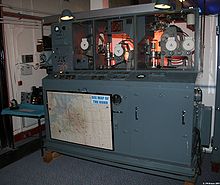GEE (navigation)
The GEE (English abbreviation for grid 'Gitternetz') or AMES Type 7000 (Air Ministry Experimental Station) was a British radio navigation system during the Second World War . The American LORAN system was developed according to the same principle .
Technical details
GEE transmitters sent impulses that were precisely timed. The navigators of the aircraft that used the GEE system, such as B. the heavy bombers of the RAF , observed the time of signal reception on an oscilloscope . If the pulses sent from two different stations arrived at the same time, it meant that the aircraft was equidistant from both stations. The navigator was then able to draw a line on a map showing the possible positions within the corresponding distance to the transmitters. If the signals arrived at different times, this meant that the aircraft was at different distances from the two transmitters. The measured time difference resulted in a curve on the map on which the position of the aircraft had to lie. A further signal from a third station created another curve, which was used to determine the position of the aircraft at the intersection of the two curves.
Mission history
The GEE went into operation in March 1942 and offered an accuracy of 150 m over shorter distances, which decreased to 1 mile (1.6 km) over long distances over Germany . At the end of the range, which was about 650 km, the accuracy was only about 2 miles (3.2 km). In contrast to the German X procedure , in which the bombers flew along a beacon , the GEE signals were not directed. As a result, the direction of flight was not revealed when the radar stations were discovered.
Since, in contrast to the H2S, it was a passive system, no signals were returned that could have revealed the position of the bombers. However, the system was prone to interference, which became a persistent problem 5 months after the system was introduced. The interfering signals only worked over continental Europe, so the aircraft could continue to use the GEE system undisturbed, at least at their bases.
Broadcasting stations
"Eastern chain"
The "Eastern chain" (eastern chain) worked from June 22, 1941. The main transmitter was in Daventry , there were other stations in Ventnor ( Isle of Wight ) and Stenigot (District East Lindsey ).
"Northern chain"
The Northern chain operated from late 1942 to March 1946. The main transmitters and control stations were located at Burifa Hill in Dunnet Head , and in Caithness , Scotland . Subsidiary stations were among others:
- Scousburgh in the Shetland Islands
- Windyhead Hill, at Fraserburgh
- Sango, Cape Wrath
swell
- Alfred Price: Instruments of Darkness: The History of Electronic Warfare (Peninsula, Los Altos, 1977) pp. 98-104
- RV Jones , The Wizard War: British Scientific Intelligence 1939-1945 (Coward, McCann and Geoghegan, New York, 1978) pp. 217-222
- Brian Johnson: The Secret War (BBC, London, Methuen, New York, 1978) pp. 84-89
Weblinks (English)
- Radio navigation systems ; Information and explanations about the GEE.
- Imperial War Museum page ; Information about restored GEE receivers.
- Radarpages.co.uk page ; Information about the technology of the system.
- GEE - WWII Hyperbolic Navigation System on YouTube , accessed December 15, 2019 (report by contemporary witness John W. Howland).


